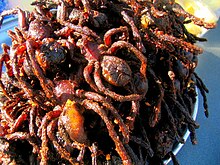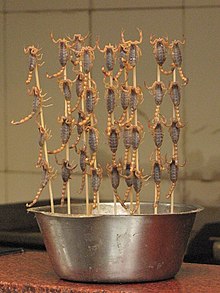

Some arachnids may be used for human consumption (edible arachnids), either whole or as an ingredient in processed food products such as cheese (Milbenkäse).[1] Arachnids include spiders, scorpions, and mites (including ticks).

About 15 species of spiders are scientifically described as being edible, with a history of human consumption.[2] These edible spiders include:

Fried scorpion is traditionally eaten in Shandong, China.[4]

Milbenkäse (mite cheese) is a German speciality cheese.
Mimolette is a mite cheese traditionally produced around the city of Lille, France.
Cheese mites could cause an allergic reaction if consumed in large quantities (above the standard of six mites per cubic inch).[5]
Typical processing of arachnids as food includes heating, defanging and, in certain cases, drying and grinding.[1]
The scientific name of this spider celebrates its culinary merits. French naturalist Jacques Labillardiere bestowed the name in 1799 after seeing the spiders roasted and eaten in New Caledonia.
[...] the Food and Drug Administration began holding shipments of Mimolette because of tiny mites on the rind. They deemed the mites an allergen and health hazard [...]
|
| |||||
|---|---|---|---|---|---|
| Poultry |
| ||||
| Livestock |
| ||||
| Game |
| ||||
| Fish |
| ||||
| Shellfish and other seafood |
| ||||
| Insects |
| ||||
| Cuts and preparation |
| ||||
| List articles |
| ||||
| Ethics and psychology |
| ||||
| Alternatives |
| ||||
| Meat science |
| ||||
| Meat industry |
| ||||
| Related subjects |
| ||||
| |||||
This food-related article is a stub. You can help Wikipedia by expanding it. |